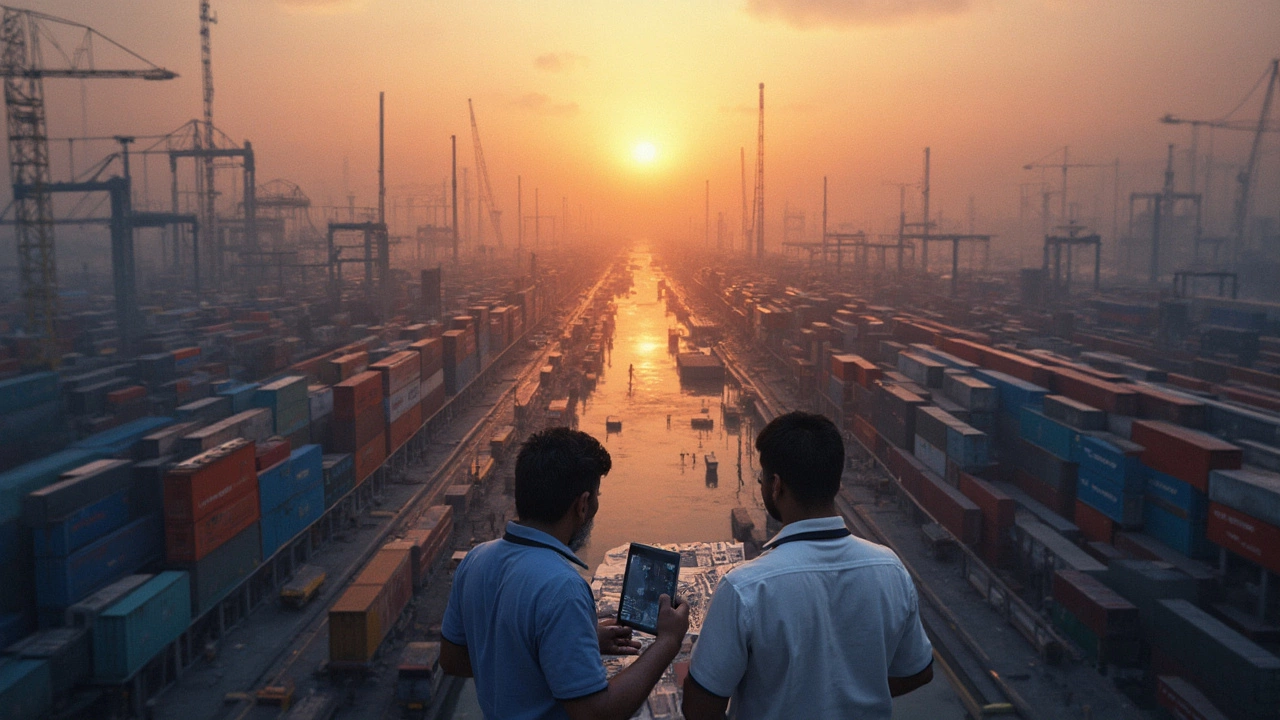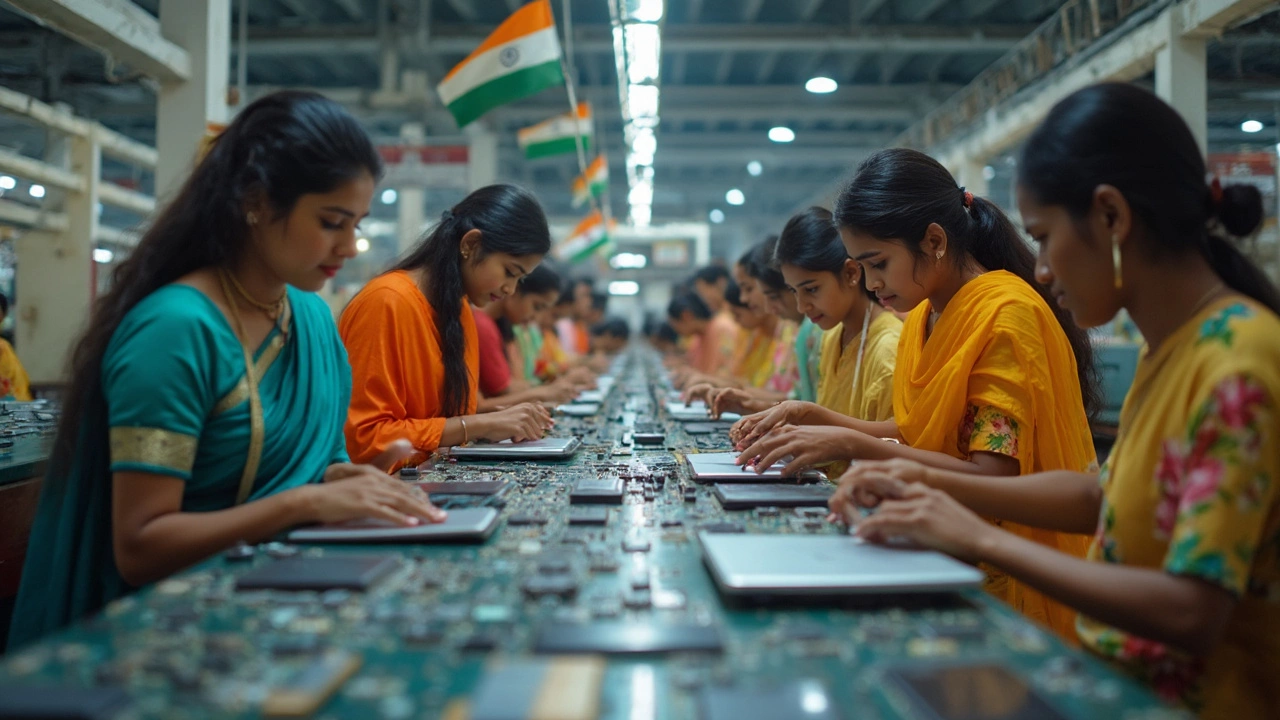
Ever checked the back of your phone or laptop and wondered where it really came from? It's not just a random country stamp—there’s a whole world of factories, supply chains, and tech wizards behind that label.
For years, China has been the king of electronics manufacturing. If you own a smartphone, a tablet, or even those noise-canceling headphones, odds are they got their start in one of China’s massive factories—think Foxconn, which can look like a city all on its own. But here’s the twist: India is coming up fast. Over the past few years, more companies are setting up shop in places like Chennai and Noida. Big names like Apple, Samsung, and Xiaomi are opening plants, making India a serious contender.
But why do certain countries dominate? There’s a mix of skilled workers, huge investments, and a fine-tuned supply chain. We're talking about hundreds of parts coming from dozens of countries, somehow landing together to build that gadget you buy at the mall.
- The Global Champion: Which Country Rules Electronics
- Rising Stars: India's Growing Power
- Why China Still Reigns Supreme
- How Electronics Get Made: From Chips to Gadgets
- What Makes a Country Good at Electronics
- What This Means for You: Tips and Insights
The Global Champion: Which Country Rules Electronics
If you had to guess where the highest number of gadgets are made, the answer is clear: China. This country cranks out more laptops, smartphones, TVs, and tablets than anywhere else, and there’s data to back that up.
Just look at the numbers. According to World Bank data, China made up over 30% of global electronics exports by value as of late 2023. While other countries are starting to catch up, China’s lead is still massive. Cities like Shenzhen and Guangzhou are famous for their high-speed, super-efficient factories, producing everything from your Bluetooth earbuds to high-end gaming laptops.
| Country | Share of Global Electronics Manufacturing (%) |
|---|---|
| China | ~30 |
| Vietnam | ~5 |
| South Korea | ~4.8 |
| India | ~3 |
| USA | ~2.1 |
Here’s what you might not know: China isn’t just pumping out cheap stuff. They build flagship iPhones and foldable Samsung phones. China’s manufacturing juggernauts like Foxconn, Pegatron, and BYD handle work for some of the world’s biggest brands. No wonder industry insiders often say, "If it isn’t assembled in China, it’s probably just designed elsewhere."
“China’s ecosystem for supply and manufacturing is unmatched. If you want to scale up quickly, this is where you come.” — Dieter Zetsche, former CEO of Daimler AG
If you’re wondering why this is possible, it isn’t just cheap labor. The real advantage is electronics manufacturing infrastructure. This means ready access to raw materials, vast networks of suppliers, and logistics that move parts across the country like clockwork. China can assemble an iPhone in hours, moving everything from screens to chips down the road from one supplier to another.
Of course, there are challenges too—trade tensions, labor conditions, and the world’s growing interest in shifting production elsewhere. But for now, China is still the top dog when it comes to electronics. If history is any signal, that’s not changing overnight.
Rising Stars: India's Growing Power
India’s electronics manufacturing industry is moving fast these days, catching the eye of the whole world. A decade ago, India was barely in the picture for global electronics, but that’s totally changed. Today, India stands as the world’s second-largest mobile phone producer, right behind China.
Big tech companies like Apple and Samsung aren’t just thinking about making gadgets in India—they’re already building them here. Apple started producing iPhones in Chennai and Bengaluru, and now about 14% of the world’s iPhones roll out of Indian factories (as of 2024). Samsung makes its Galaxy smartphones at the Noida plant, which is actually the world’s largest phone manufacturing facility by volume.
Here’s a quick look at just how much India has grown in this space:
| Year | Electronics Production Value (USD Billion) | Mobile Phones Produced (Million Units) |
|---|---|---|
| 2014 | 29 | 58 |
| 2018 | 70 | 225 |
| 2023 | 108 | 310 |
Why now? For starters, the government launched a bunch of friendly schemes, like the Production Linked Incentive (PLI), that give companies cash rewards for making electronics in India. There are also easier rules for setting up factories, and tariffs that make importing finished goods pricier than local manufacturing.
Want to know why India is suddenly a big deal for brands? Here’s what’s making the difference:
- Massive workforce—India churns out millions of engineers and technicians every year.
- Costs are much lower than in the US or Europe, and right now, some skilled labor is even cheaper than in China.
- India’s market is huge. Why ship gadgets halfway across the globe when you can build and sell right here?
All this growth means that more devices you see in shops—especially in Asia and Africa—are built in India. The electronics manufacturing wave here is just getting started, and plenty of global supply chains are now looking east toward Indian factories.
Why China Still Reigns Supreme
If you’re talking about electronics manufacturing, China is still the boss. Sure, other countries are catching up, but China’s lead isn’t just about cheap labor anymore—it’s about the full package.
China figured out the electronics playbook early. Factories like Foxconn, Pegatron, and BYD aren’t just making random gadgets; they’re putting together iPhones, PlayStations, laptops, and just about every Bluetooth earbud you’ve ever lost in your couch. Their cities are loaded with specialized “clusters” of suppliers and workers. If you need a screen, chip, or tiny screw, there’s a supplier next door with a million ready to go. That makes production lightning fast compared to most countries.
Besides scale, China offers crazy logistics. Shenzhen, for example, feels like an electronics theme park. Trains, highways, and ports connect every piece of the supply chain so that a chip made in the morning could be inside a finished phone by dinner. Companies just don’t get that kind of speed or flexibility anywhere else.
Look at these 2024 stats to see just how dominant China really is:
| Category | China's Share | World Total |
|---|---|---|
| Smartphones | Over 70% | 1.39 billion units |
| Consumer Electronics | Above 60% | $1.1 trillion market |
| Industrial Robots | 51% | 553,000 units installed globally |
| Global Semiconductor Packaging | 36% | By manufacturing revenue |
High-tech doesn’t stop at assembly, though. China’s got a workforce that understands microchips, robotics, and coding. There are bootcamps and technical schools everywhere, so the talent pipeline never really runs dry. The government also chips in with tax breaks, science parks, and sometimes land—so it’s easier and cheaper for companies to build massive plants in months, not years.
For anyone wondering if things will change soon, keep in mind: Most big tech brands still design their gear in the US or Europe, but they build millions of units in China. When Apple launched the iPhone 15, factories in Zhengzhou were shipping them worldwide within days. That kind of muscle—and speed—is hard to copy. Even with rising labor costs and talk of moving factories elsewhere, China’s full setup is why it continues to own the electronics game right now.

How Electronics Get Made: From Chips to Gadgets
If you’ve ever wondered why a phone can cost less than a fancy dinner out, it all comes down to how efficiently countries build these things. Every electronics manufacturing hub shares one thing: a lightning-fast process to turn raw materials into shiny gadgets.
It usually starts at the chip foundries. Semiconductors (the brains inside every device) get made in places like Taiwan, South Korea, and increasingly, India. After the chips are baked, they get shipped to assembly plants—China still does this at a mind-blowing scale, but India is catching up fast. There, circuit boards, screens, cameras, batteries, and those tiny screws all come together, each from different suppliers.
Here’s what typically happens in an assembly line:
- Printed circuit boards (PCBs) are loaded with tiny components by automated machines.
- Chips are placed onto the boards and soldered down with precise heat—automation rules here.
- Touchscreens, batteries, and cameras are snapped into place by robots and humans working side-by-side.
- Casing closes it all up, devices are checked for quality (and yes, a lot get rejected for tiny flaws).
- The finished product gets packaged—with chargers, manuals, and sometimes those cheap earbuds—and shipped out worldwide.
It might sound simple, but the scale is wild. Some Chinese "mega-factories" push out more than 500,000 smartphones a day. Foxconn’s Zhengzhou plant employs well over 200,000 people, running 24/7 shifts. Meanwhile, India’s production of mobile phones shot up from about 60 million units in 2014 to over 330 million units in 2022. That’s a five-fold increase in less than a decade.
Here’s a snapshot of how big the numbers really get:
| Country | Annual Smartphone Output (2023) | Major Brands Made |
|---|---|---|
| China | 1.3 billion | Apple, Xiaomi, Huawei |
| India | 330 million | Samsung, Apple, Xiaomi |
| Vietnam | 185 million | Samsung, Oppo |
One tip: if you ever see a long shipping delay, it’s probably got something to do with these giant assembly lines, a part shortage, or a sudden shutdown somewhere in the world. Electronics only seem to get faster and cheaper if every part of this chain works perfectly. The next time you unbox a new device, just know it’s already traveled through dozens of hands (and machines) before landing with you.
What Makes a Country Good at Electronics
So what’s the secret sauce that helps a country become a serious player in electronics manufacturing? It isn’t just cheap labor or a few shiny factories. There are a handful of ingredients that make all the difference.
- Skilled workforce: You can’t build cutting-edge gadgets without people who know what they’re doing. China and India both have millions of engineers and technicians coming out of schools every year.
- Access to raw materials: Chips, screens, batteries—even something basic like plastic needs a steady supply. Having close access keeps costs down and production moving.
- Massive factories and world-class infrastructure: Ever seen a Foxconn campus? It’s wild—some plants have over 200,000 workers. Countries with strong roads, ports, and electricity grids always have an edge.
- Government support: Look at the tax breaks in China or “Make in India” push. When the government makes it easier, businesses follow.
- Big supply chain networks: You need suppliers close by, so you can tweak designs or grab extra parts fast. Shenzhen, for instance, is famous for its electronics markets and supply chain web.
Money is big, too. You need billions to set up chip plants, robot assembly lines, and fancy testing labs. Countries winning at electronics are usually investing hard in research and innovation. South Korea, Taiwan, and Japan built their rep this way.
| Factor | Why It Matters | Examples |
|---|---|---|
| Skilled Workforce | Builds complex devices & keeps quality high | China, India |
| Access to Materials | Keeps costs low & supply steady | China, Taiwan |
| Solid Infrastructure | Faster shipping & better efficiency | China, Vietnam |
| Government Support | Attracts investment & supports local companies | China, India |
| Connected Supply Chains | Faster tweaks, less downtime | Shenzhen, Singapore |
The big takeaway? It’s not magic. Countries that score high on these fronts tend to pull ahead—think China, South Korea, or now, India racing up the list. The more a country doubles down on these basics, the more likely it’ll be to fill your next gadget.
What This Means for You: Tips and Insights
Your phone’s label isn’t just trivia—it affects your wallet, upgrade cycle, and even how fast you get repairs. Since electronics manufacturing powerhouses like China and, increasingly, India are turning out most gadgets worldwide, global prices and availability follow what happens in their factories. For instance, when COVID-19 hit Chinese plants, people waited longer for phones, and prices went up everywhere. If India keeps growing, supply chain risks might spread out and stabilize things for buyers worldwide.
Knowing where your gadgets are made can actually save you money—and headaches. Want to score a better deal? Watch local news from India or China for reports on new factories or trade changes. When plants open in India, products sometimes launch with local discounts or promos. If you buy from brands like Samsung or Xiaomi, you can check where their latest factories are—local production cuts shipping costs, which can leave more cash in your pocket.
- Always check the official site’s product info—many list the plant location now.
- Looking for quick repairs? Devices made in India are easier and faster to service if you live in or near the region—local parts and jobs keep things moving.
- If you spot news about strikes, pandemics, or weather in a big manufacturing region, you can expect delays or price hikes—shop early or wait it out.
- Keep an eye on environmental reports—countries with cleaner, stricter standards may produce more eco-friendly devices.
Here’s a look at the share of global electronics output from top manufacturers last year:
| Country | Share of Global Electronics Production (2024) |
|---|---|
| China | 35% |
| India | 8% |
| Vietnam | 5% |
| South Korea | 7% |
| United States | 6% |
It pays to stay curious. Every time one of these countries ramps up (or slows down) production, it shakes up what’s available in stores near you. That’s why keeping an eye on the big manufacturers can help you plan your upgrades, spot the best deals, and even choose more reliable brands.




